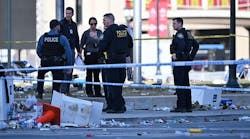Over the past few years campus law enforcement has taken some dramatic turns and faced some interesting challenges. There is greater scrutiny regarding how campus security professionals conduct investigations and report on-campus sexual assaults as a result of several recent incidents at the University of Montana. Campus law enforcement has also been assaulted by other forces including occupy protestors, civil suits, and a rash of ongoing campus threats in the form of active shooters, radicalization of students, suspects of terrorism, and liberal professors. However, there are five topics that appear in almost every conversation involving a campus law enforcement professional. They include federal monitoring, community policing, National Campus Public Safety Center, technology, and obviously the future of this noble industry.
Tracking the Top Five Issues
Federal Oversight – If you are college law enforcement professional, and you are not aware of the federal oversight at the University of Montana for their perceived failure to conduct appropriate investigations relating to sexual assaults, you are already at risk. The Department of Justice and Education conducted a lengthy investigation and determined that the University of Montana Police, Missoula City Police and the county attorney’s office had created an environment where there was a practiced pattern of violating the civil rights of women for supposedly failing to protect them. The university’s head of campus security told federal officials that his department did their best to assess if the victim’s claim was "provable" and whether it seemed "credible" during their initial interview. The United States Department of Justice stated that the university’s assessment of the victims was “in direct contradiction" to what the role of a first responder should be.
Roy L. Austin of the Justice Department Civil Rights Division said in a statement. "The problems we found at the University of Montana were real and significant. These concerns, however, are not unique to this campus. The women who are subject to sexual harassment and assault know that without support the devastating consequences for them, their classmates and their community are made all the worse. Institutions of higher learning across the country must be absolutely tireless in their determination to fully and effectively respond to reports of sexual assault and sexual harassment on their campuses involving their students."
I have authored a couple of articles related to this topic. The crux of the material is that the federal government is currently conducting reviews of more than 55 law enforcement agencies on college campuses for Clery Act and Title IX investigation failures. This means campus administrators need to be aware that they are no longer working within the confines of the once fabled “ivory towers”. Parents, students, educators and lawmakers are watching and making sure that campus departments and agencies are compliant. It is no longer enough to simply know the laws.
Use of Force -- Traditional law enforcement agencies have been faced with federal civil rights lawsuits for decades. They are commonly referred to as a 1983 action, and are generally filed against government agencies for violations or deprivation of civil rights -- specifically excessive force, false arrest or violations of due process as it relates to law enforcement. As a result of the recent protesting environment on college campuses (UC Campuses/Occupy Protestors/ general protests), dealing with the civil rights of their student population is something campus law enforcement is top of mind. Knowing that today’s “You-tube” generation can record, post or tweet any incident within seconds of them occurring, a new set of social skills and restraint is certainly required. In the past six months there have been lawsuits filed in California against San Francisco City Colleges and against Drexel University for violating the rights of students and use of excessive force. These claims illustrate a growing trend of claims against campus law enforcement, which are not just coming from students or other college stakeholders.
Community Policing – Community policing on college campuses is front of mind again for campus law enforcement as organizations attempt to do more with less. Officers on college campuses are poised for dramatic increases in their campus safety roles. This higher profile was enhanced when the U.S. Department of Justice awarded a $2.3 million grant to establish a new National Center for Campus Public Safety in 2013. The grant was awarded to Vermont-based Margolis Healy & Associates LLC, which has created the center in partnership with the University of Vermont (UVM).
Establishing and leading the National Center is the responsibility of Margolis Healy, a national consulting firm specializing in educational safety and security, headed by former UVM Police Chief Gary J. Margolis and Steven J. Healy, former Director of Public Safety at Princeton University. The National Center will serve the safety and security needs of higher education throughout the United States. The National Center was chartered by Congress earlier this year with bipartisan support, in the wake of recent school tragedies.
The National Center for Campus Public Safety is designed to be a centralized resource for campus police chiefs, directors of public safety, emergency managers and key campus safety stakeholders at the nation’s colleges and universities. Its goal is to bring together many forms of campus public safety, professional associations, advocacy organizations, community leaders, and others to improve and expand their resources to ensure the safety and security of their students and communities.
Community policing has been under closer scrutiny by some in the media in light of recent large-scale protests and near riots related to collegiate sporting events. While law enforcement and security professionals certainly deem their action as an appropriate response to the situations, media and those in the general public have speculated other tactics could have been used to defuse the incidents.
In the past there has often been a mixed relationship between specialized law enforcement and traditional law enforcement agencies that control and conduct on-campus criminal investigations. This apparent confusion was apparent during the investigations at the University of Montana in conjunction with the DOJ. Unfortunately violence does not exist in a vacuum, witnessed by recent horrific off-campus shootings involving former college students like James Holmes, who shot 12 people to death in a Colorado movie theater and Jared Loughner, now serving a life sentence for his attempted assassination of Arizona Congresswoman Gabby Giffords. The need for shared information amongst all law enforcement and public safety agencies certainly has expanded to include college and university police professionals. Investigators and law enforcement must be proactive and create a thorough collaborative partnership.
Finally, information sharing between public and private law enforcement officials must also remain current and proactive with regards to criminal investigators using social media to conduct and supplement their investigations. Social media is quickly changing law enforcement tactics, as seen in a recent case at James Madison University. Three fraternity members were recently punished by the school for sexually assaulting a female student and then sharing the video of the attack on social media; their punishment? Each was banned from campus – but not until after they graduate. The unusual "expulsion after graduation" sanction allowed two of the men to graduate on time this past May, with the third planning to remain on the Harrisonburg, Virginia campus for his senior year in 2014-15.
The assault victim’s complaint to federal officials about the school's handling of the attack prompted an investigation by the U.S. Department of Education's Office for Civil Rights, which opened this past June, reviewing whether JMU violated the gender equity law Title IX. This case demonstrates the importance of colleges monitoring student social networks.
Technology -- Campus public safety is facing a new paradigm. The days of walking around with flashlights and a set of keys are over. Campus public safety professionals need to possess robust skill sets. But officers also need help to do their jobs. To that end there are numerous technologies that can assist a public safety professional.
One of the most basic is the patrol car, along with other “patrol-type” technologies like the T-3 and Segway. There are also a host of “non-lethal” technologies that can provide officers options, including the Guardian 8 non-lethal weapons platform, Taser devices, simple pepper spray, and even sophisticated night sticks. Couple these with software and mobile applications such as crime reporting, communication and police or law enforcement-related apps, and an officer can instantly review laws, past and current cases, policies and procedures. One can augment all this with the development of computer based training, which allows campus safety professionals to receive relevant skills without leaving their campus, shift or assignment.
Conclusion
There are a set of diverse and complex issues facing today’s campus law enforcement and public safety professionals. Many are at the tipping point when it comes to federal agency oversight. Colleges that have never allowed armed officers are now considering the concept. Campus law enforcement and campuses are being tied to more violent crimes, leading to more urgency for collaborative policing practices. College campuses are becoming more radicalized and students are more self-aware of world events on the impact on their own lives. Social issues, world events and expanding mobile and social media will continue to challenge campus policing to change with the times.
About the Author:
Dr. Matt Stiehm received an Educational Doctorate from Argosy University, where the focus of his research was campus safety and security. He has a Master’s Degree of Criminal Justice from Central Missouri State University, and a BS from Wayne State College, Nebraska. He has served as a police officer in three states. He currently is a member of ILEETA, MN Infragard, FBI LEEDS, an Associate Member of the IACP, Support Member of the MN Chiefs Association, the Midwestern Criminal Justice Association, and recently Police Executive Research Forum Subscribing Member.


